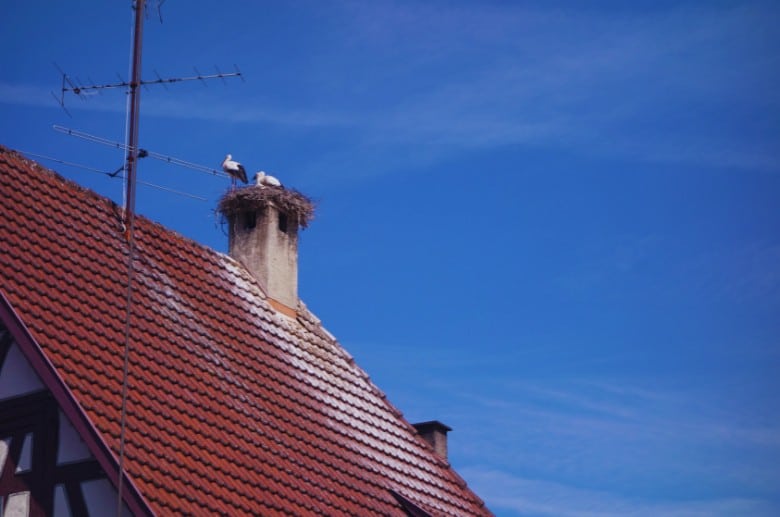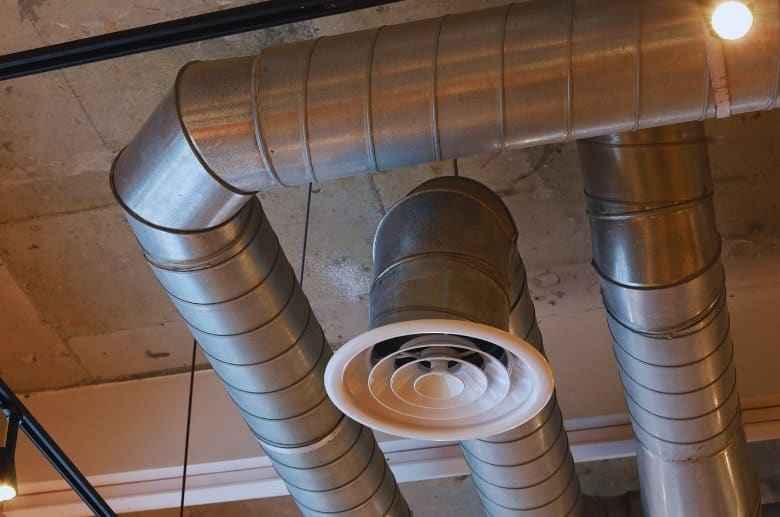Basements, in particular, offer an ideal setting for a fireplace installation. This lower level can efficiently heat multi-story homes through the stack effect and transform all levels into inviting retreats.
But sometimes, unwanted odors from the fireplace hearth can become an issue.
Whether you’re a homeowner or a contractor considering a basement fireplace in your home improvement projects, understanding how to tackle fireplace odor in basement is essential.
Causes of Fireplace Odor in Basement
Odor in basements can often arise from various sources, including creosote buildup from fireplace wood stoves, emissions from gas fireplaces, moisture, poor ventilation, and even animal nests. When considering a fireplace in the basement, it’s essential to be aware of these potential odor sources. Here’s a deeper look into the most common causes.
1. Creosote buildup

As time passes, a layer of soot and creosote tends to gather within the chimney and fireplace. These hazardous substances build up from burning wood and remain trapped in your chimney walls until properly eliminated. This accumulation can create an unpleasant smell when the fireplace in your basement is in use.
As experts, we advise homeowners to use dry and well-seasoned wood or logs to kindle the blaze and minimize the creosote accumulation.
It’s crucial to schedule a professional chimney inspection and cleaning annually. This maintenance will effectively eliminate the buildup, significantly reducing the risk of chimney fire.
——
Do You Need to Hire Chimney & Fireplace Expert?
Get free quotes from qualified experts near you. No commitment required!
——
2. Moisture
Addressing water leaks can pose a challenge as their origins aren’t always limited to the roof and gutters. To pinpoint the source of a leak, arrange an inspection.
Surprisingly, a basement fireplace is frequently overlooked as a potential culprit. The fireplace might have issues with humidity and moisture, which creates mold and mildew, harming the health of the occupants. This also happens to your attic, bathroom, and even your doors.
Installing a chimney chase cover is the most efficient method to mitigate moisture within the chimney. It acts as a shield from rainwater or snow. Chase covers seal the chimney’s upper part, acting as a flue pipe extension and protecting against water damage.
A chimney chase cover can also add value to your home construction by up to 10%, as it has various sizes and colors you can choose from that will fit your home’s appearance and thus improve curb appeal.
To prevent the stack effect, which is the natural flow of air inside a building due to warm air rising, it’s essential to ensure proper sealing of the chimney chase at both the bottom and the top. This sealing process prevents outside air from infiltrating the cavity.
Additionally, sealing the top of the enclosure is crucial because it effectively stops air movement, as there’s no escape route from the sealed enclosure. By particularly focusing on sealing the top of the enclosure, you can significantly reduce the intrusion of warm air, which is the primary cause of moisture issues.
3. Poor ventilation
Problems with air circulation within the home can play a role in causing fireplace odors. Negative air pressure can reverse smoke and odors, drawing them back into the house instead of effectively venting them outside.
Homeowners should ensure that the fireplace causing the air pressure problem is equipped with outdoor combustion, allowing odors to be efficiently vented outside instead of lingering indoors.
4. Animal nests

Animals or pests like birds or squirrels can enter the chimney flues, create nests, or leave debris, creating unpleasant or musty smells. These creatures might bring in food and garbage or leave droppings, contributing to the undesirable odor.
Handling wild animals can pose risks due to the potential for bites and disease transmission. Professional chimney sweeps are skilled and prepared to address such situations safely and effectively.
What are The Health Risks of Fireplace Odor?
Fireplace odors in basements go beyond mere discomfort; it can entail potential health hazards such as respiratory issues. Understanding these risks highlights the critical need to address and eradicate odors, fostering a safer and healthier environment for living.
Respiratory issues

Specifically, wood smoke comprises small particles and gases that, when inhaled, can lead to significant health consequences. Research shows that breathing in smoke from a wood burning fire can result in respiratory problems such as coughing, wheezing, and difficulty breathing.
This is because particle pollution, carbon monoxide, nitrogen oxides, and volatile organic compounds are released when wood is burned. These pollutants can harm indoor and outdoor air quality, affecting one’s health.
In addition, fine particles can worsen asthma symptoms and trigger asthma attacks. According to the Environmental Protection Agency, these particles can also trigger heart attacks, stroke, irregular heart rhythms, and heart failure, especially in people at risk for these conditions.
If you have a family member with asthma or other respiratory problems, it’s important to immediately address any fireplace odor in the basement.
Headaches and dizziness

Similar to wood smoke, the odor of burning gas can also trigger sensitivity, headaches, dizziness, and related problems for certain individuals.
This effect can be particularly pronounced with ventless gas fireplace logs. These logs lack a chimney or vent to dissipate the fire’s fumes and embers, often resulting in a more pronounced smell that smells like sulfur, particularly in new or infrequently cleaned fireplaces.
The sulfur-like odor emitted by a ventless gas fireplace could indicate a carbon monoxide leak. Carbon monoxide is produced when burning fuel in various appliances, such as vehicles, stoves, grills, fireplaces, and furnaces.
Breathing in significant quantities of nitrous dioxide and carbon monoxide can lead to harmful poisoning of individuals and animals exposed to it.
Research shows that more than 400 Americans die from unintentional carbon monoxide poisoning not linked to fires yearly, more than 100,000 visit the emergency room, and more than 14,000 are hospitalized.
If you experience difficulty breathing or smell something like sulfur or gas, contact a chimney technician right away.
——
Do You Need to Hire Chimney & Fireplace Expert?
Get free quotes from qualified experts near you. No commitment required!
——
How to Get Rid Of Fireplace Odors In Basement
Here are the steps you should take to solve fireplace odors in the basement for a pleasant environment and improve your home’s air quality. We’ll look into strategies like cleaning, sealing, and improving ventilation.
Step 1: Cleaning your fireplace and chimney
You can adopt a DIY approach to maintain your fireplace and chimney, minimizing the risk of odors.
Begin by collecting the necessary tools, such as a chimney brush, chimney rods, vacuum cleaner, drop cloths, and a dust mask for safety. Shield the surrounding area with drop cloths or newspapers to catch falling debris during cleaning. Then, remove loose debris and ashes from the firebox using a fireplace shovel, and use a stiff brush to scrub stubborn soot stains from the firebox walls.
Address the flue by attaching the chimney brush to rods and inserting it into the flue from the bottom. Move the brush up and down to dislodge creosote buildup. Finally, use a vacuum cleaner with a hose attachment to clean up debris that may have fallen into the firebox and fireplace hearth.
Now the question arises, “How frequently should I clean my chimney?” We recommend doing it after approximately 50 burns or when soot accumulates to a depth of 1/8 inch.
If you are still determining the necessity of cleaning, doing a chimney inspection is wise. Chimney cleaning serves not only to eliminate fireplace odors but also to avert hazardous scenarios like fires.
Regular maintenance and cleaning of your chimney are fundamental aspects of ensuring the safety and functionality of your fireplace system. These measures not only promote a cleaner and more efficient chimney but also provide peace of mind for you and your family as you enjoy the warmth and comfort of your fireplace.
Step 2: Sealing the chimney
Ensure a thorough and secure chimney closure for durability. Also, you can utilize fireplace plugs or draft stoppers to counteract downdrafts, redirecting air intake through alternate pathways within the house.
To seal your fireplace, thoroughly clean the chimney and then secure the rooftop chimney cap. Following this, shut the damper and place insulation inside the flue before securing it.
Similarly, you can also create a DIY cover. To craft a removable and aesthetically pleasing cover, shape a two-inch foam to fit the opening. Leave a small margin of about 1/8 to 1/4 inch around all sides to accommodate wrapping with fabric. Enhance the appearance by draping a cozy blanket or a fabric that compliments your decor over the foam.
Step 3: Improving ventilation of your basement area

Enhancing ventilation within the basement can effectively diminish odors. Utilize fans or open windows to enhance air circulation, reducing the concentration of unpleasant smells.
Also, we advise installing floor fans and a dehumidifier as supplementary choices to maintain proper basement ventilation.
Alternatively, consider incorporating exhaust fans linked to vents thoughtfully positioned throughout the basement. These fans can be permanently affixed to windows or create openings in basement walls for installation.
DIY vs Professional Solutions
You’re aware that your chimney needs cleaning, but you’re hesitant to go through the hassle of hiring a professional company for the task. The question now is “Should you tackle the issue yourself or get professional help?”
DIY solutions might save money but need more expertise, while professionals offer comprehensive service. Here are some tips for deciding when to act independently or when to call in experts.
DIY Solutions Pros and Cons
- Cost savings – Going for DIY fireplace cleaning can be cost-saving, provided you possess the necessary expertise. Properly cleaning and maintaining a chimney involves various considerations.
If you have knowledge of chimney cleaning and have a limited budget, there are various DIY options using household products like baking soda, vinegar, charcoal, and air purifiers.
- Less buildup – The best times for chimney maintenance are just before using your fireplace and, if feasible, after the season ends.
Performing chimney cleaning more often has its benefits. Extra effort now leads to less effort later. Neglecting regular upkeep can result in stubborn, accumulated buildup that becomes harder to remove over time. This will also help your chimney sweep easily clean your chimney when the time comes.
- Lack of expertise – When you DIY, there’s a huge possibility that you don’t have the necessary skills and information to tackle the project. This also goes with fireplace cleaning.
There may be videos, references, and a variety of source material from the internet that you can use. However, this will only be a temporary solution to your odor problem.
If you want a permanent solution, it’s best to leave it to chimney technicians as they can do a more thorough job.
- Lack of proper equipment – Lack of proper equipment poses safety risks for DIYers attempting chimney flue cleaning. Handling hazardous substances like soot, creosote, and toxic fumes without a professional-grade respirator mask can be dangerous.
In addition, equipment such as rotary chimney brushes and ladders may not be available to you. A chimney sweeping company has all it needs to do the job properly.
Professional Solutions Pros and Cons
- Hidden issues – When attempting DIY fireplace and chimney maintenance, you may overlook hidden hazards that professionals can detect. Your chimney’s various components must function together for safety from fire, carbon monoxide, and water damage.
Many problems in these areas can remain unnoticed without specialized knowledge. Engaging in DIY projects can lead to either missed problems or accidental damage if structural issues exist. Moreover, A professional can spot issues like brick, mortar, damper, and flue problems that DIYers might miss.
Over time, weather and exposure lead to chimney deterioration. Regular inspections and cleanings can prevent costly issues like damaged flue liners, warped dampers, and cracked crowns. Catching these early saves time, money, and enhances fireplace safety.
- Expertise and comprehensive service – The Chimney Safety Institute of America advises an annual chimney and fireplace inspection, with professional cleaning as necessary. Specialized skills and tools make hiring a professional a wise choice.
Certified chimney sweeps possess the expertise and equipment like brushes, solvents, and vacuums to safely remove creosote buildup without harming the chimney’s interior.
Just as you’d trust a skilled physician, hiring a certified chimney sweep ensures expert handling. Their in-depth knowledge surpasses that of an average person, making them the best choice for thorough and safe chimney cleaning.
- Higher costs – If you’re on a limited budget, you may find hiring a professional chimney business is costly. The expense for chimney cleaning averages around $250, typically falling within a range of $120 to $390.
This is the reason why many homeowners tend to DIY this task. DIY solutions only range from $50 to $70. However, this is only temporary, and you risk damaging your basement fireplaces.
- May disrupt daily schedule – Since chimney cleaning may take a long time, this may prevent you from doing other chores. Or, if you’re someone who’s not comfortable with people coming over your house, then hiring a chimney sweep may not be ideal.
If this is the case, doing it yourself may be the best option.
Cost of Fireplace Odor Solutions
Basic chimney cleaning services typically range from $120 to $390 for cleaning a chimney in good condition.
Prices generally cover routine cleaning and checks. However, several factors affect these costs:
- Location and local living costs (urban areas may be pricier than rural areas).
- Usage frequency.
- Chimney materials like concrete or stone.
- Specific cleaning methods and solutions.
Furthermore, difficulties accessing the chimney, such as steep roofs or obstructions like trees or solar panels, can raise the price.
Other potential charges include fireplace fixes or additional services, e.g., removing animals. Below is a table detailing services that might add extra costs:
| Type of service | Price |
| Fireplace Damper | New Installation – $200 – $350 Repair – $100 – $225 |
| Chimney and Flue Liners | Installation/Replacement – $1,550 – $6,000 Repair – $280 to $1,350 |
| Chimney Caps | Repair/Replacement – $115 to $850 |
| Chimney Flashing | Installation/Repair – $215 to $520 |
| Animal Removal | Ranges from $180 to $560 |
To ensure the safety and efficiency of your fireplace, it’s recommended to have annual chimney inspections and cleaning conducted by certified professionals. This proactive approach can prevent potential issues and avoid costly repairs.
How To Prevent Fireplace Odor In The Future
Prevention is the key to avoiding future odor problems. Here are preventive measures you can take.
- Regular chimney maintenance – Incorporate chimney care into your regular home maintenance routine.
- Empty fireplace ash – You should empty fireplace ashes after each use, leaving around an inch of ash for a hotter flame that minimizes buildup and helps make professional cleaning more effective and economical. Consider using creosote logs to break down the buildup. They cost about $15.
- Use seasoned wood – The Chimney Safety Institute of America (CSIA) advises using well-seasoned dry softwoods instead of damp, green wood for fires that burn hotter and produce less smoke.
- Do exterior checks – For the exterior of your chimney, ensure a functional chimney cap, flashing, and shingles, and trim any overhanging trees that could potentially harm the masonry.
Conclusion
With years of training and expertise, a trained chimney sweep team can identify issues within the fireplace. Until you gain such knowledge, rely on a certified professional to inspect and safely clean the interior of your fireplace.
There are many things that you should keep in mind when taking care of your fireplace. Addressing fireplace odor in your basement is vital for comfort and health. Understanding the causes, health risks, and solutions helps you to eliminate odors and prevent their return.






